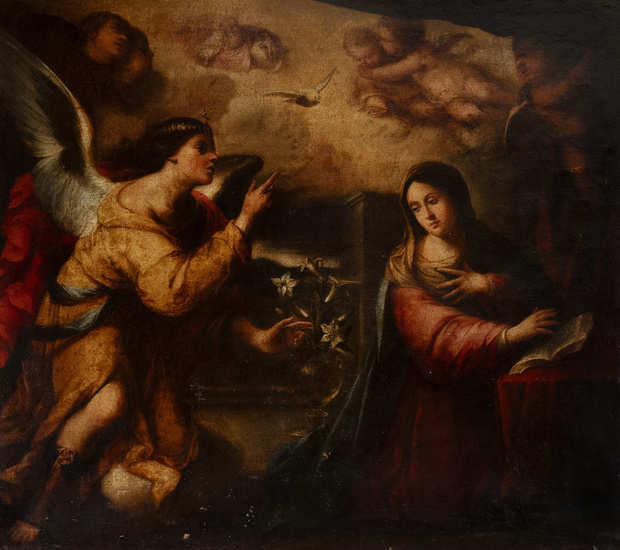Andalusian School; XVII century.
Andalusian School; XVII century.
"Annunciation".
Oil on canvas. Relined.
It presents faults and restorations on the pictorial surface.
It has a frame of the nineteenth century.
Measurements: 102 x 113 cm; 122 x 133 cm (frame).
A break of Gloria of golden and indeterminate light centers the attention on the figures, located in the foreground, as it corresponds to this subject following the approaches arisen in the Council of Trent. Mary, dressed in red tunic, blue mantle and white veil covering her hair, appears seated before a lectern with a book, making the usual devotional gesture made with her hands before the arrival of the Archangel. The clothes of this second figure, the Archangel Gabriel, appear moved by the wind, while with his hands he points to the Virgin and towards the sky where the presence of some cherubs and the Holy Spirit can be appreciated.
The Annunciation is one of the most represented themes in Christian art for marking the Incarnation of Christ as man and as God, while Mary maintains her purity and her virginal state, points of great theological importance. Thus, throughout the evolution of the different styles in European art, there is a great variety of models and different details according to style, school and period. The present work is clearly related to Baroque works because of the palette chosen, the iconography (with details maintained from previous traditions), the hallmarks of light, etc.
The 17th century marked the arrival of the Baroque in the Andalusian school, with the triumph of naturalism over Mannerist idealism, loose workmanship and many other aesthetic liberties. At this time the school reached its greatest splendor, both for the quality of the works and for the primordial rank of Sevillian Baroque painting. Thus, during the transition to Baroque we find Juan del Castillo, Antonio Mohedano and Francisco Herrera el Viejo, in whose works the rapid brushstroke and the crude realism of the style is already manifested, and Juan de Roelas, introducer of Venetian colorism. In the middle of the century, the period reached its peak, with figures such as Zurbarán, a young Alonso Cano and Velázquez. Finally, in the last third of the century we find Murillo and Valdés Leal, founders in 1660 of an Academy where many of the painters active during the first quarter of the 18th century were trained, such as Meneses Osorio, Sebastián Gómez, Lucas Valdés and others.
COMMENTS
It presents faults and restorations on the pictorial surface.
View it on
Estimate
Time, Location
Auction House
Andalusian School; XVII century.
"Annunciation".
Oil on canvas. Relined.
It presents faults and restorations on the pictorial surface.
It has a frame of the nineteenth century.
Measurements: 102 x 113 cm; 122 x 133 cm (frame).
A break of Gloria of golden and indeterminate light centers the attention on the figures, located in the foreground, as it corresponds to this subject following the approaches arisen in the Council of Trent. Mary, dressed in red tunic, blue mantle and white veil covering her hair, appears seated before a lectern with a book, making the usual devotional gesture made with her hands before the arrival of the Archangel. The clothes of this second figure, the Archangel Gabriel, appear moved by the wind, while with his hands he points to the Virgin and towards the sky where the presence of some cherubs and the Holy Spirit can be appreciated.
The Annunciation is one of the most represented themes in Christian art for marking the Incarnation of Christ as man and as God, while Mary maintains her purity and her virginal state, points of great theological importance. Thus, throughout the evolution of the different styles in European art, there is a great variety of models and different details according to style, school and period. The present work is clearly related to Baroque works because of the palette chosen, the iconography (with details maintained from previous traditions), the hallmarks of light, etc.
The 17th century marked the arrival of the Baroque in the Andalusian school, with the triumph of naturalism over Mannerist idealism, loose workmanship and many other aesthetic liberties. At this time the school reached its greatest splendor, both for the quality of the works and for the primordial rank of Sevillian Baroque painting. Thus, during the transition to Baroque we find Juan del Castillo, Antonio Mohedano and Francisco Herrera el Viejo, in whose works the rapid brushstroke and the crude realism of the style is already manifested, and Juan de Roelas, introducer of Venetian colorism. In the middle of the century, the period reached its peak, with figures such as Zurbarán, a young Alonso Cano and Velázquez. Finally, in the last third of the century we find Murillo and Valdés Leal, founders in 1660 of an Academy where many of the painters active during the first quarter of the 18th century were trained, such as Meneses Osorio, Sebastián Gómez, Lucas Valdés and others.
COMMENTS
It presents faults and restorations on the pictorial surface.



